Being able to “reach” your target audience is one of the most essential reasons for being on social media. That’s probably why metrics like “reach” and “impressions” are so consistently reported across platforms. Unfortunately, these two important metrics are also often misunderstood or used interchangeably.
In reality, there are key differences between reach and impressions that marketers need to know — differences that ultimately affect the insights you gain from tracking them. So, let’s clear it all up. Here’s a breakdown of what reach and impressions are, including details on how they’re reported by major platforms.
Analyze your reach vs. impressions
Understanding the difference between Reach and Impressions
In general, reach is defined as the number of people who see your social media post, while impressions refer to the total number of times that post is seen by users (or at least appears on their screen).
The main difference here is that impressions count multiple views by the same user, while reach doesn’t. In other words, if a post was seen 100 times by 50 people, the post’s impressions will be 100 while its reach is only 50. For this reason, reach will always be less than or equal to impressions.
So, why would you want to track either metric?
Reach is great for finding out exactly how many individual people your content is being exposed to. It’s the most accurate answer to the question, “How many people am I reaching?”
Alternatively, impressions can give you insight into the quality of your content. For example, if impressions are greater than reach, then it’s a possible sign that the post is interesting enough for users to view it more than once. If your impressions far outnumber the number of engagements, though, then you can assume that that piece of content wasn’t engaging enough for people to actually engage with it — even if they did view it multiple times.
An important fact to remember, though, is that each social media platform has its own method for reporting each metric. Keep reading to learn more about reach and impressions on Facebook, Instagram, Twitter, and LinkedIn.
Facebook Reach vs. Facebook Impressions
Facebook officially defines reach as the number of people who saw any piece of content from your Page or about your Page at least once.
Because ads play a big role on the platform, Facebook explains the difference between paid reach and organic reach as follows:
- Paid reach is the number of people who had a paid post from your Page enter their screen.
- Organic reach is the number of people who had an unpaid post from your Page enter their screen. Organic reach is also split into two different types.
- Viral organic reach counts the number of people who had an unpaid post of yours enter their screen because their friend likes or follows your Page, engages with a post, shares a photo of your Page, or checks into your Page.
- Nonviral organic reach counts the number of people who saw an unpaid post for any other reason besides those mentioned for viral organic reach.
With so many distinctions, marketers have to be careful in interpreting their reach on Facebook.
Particularly, be aware that the sum of organic and paid reach won’t always equal total post reach. Why? Because if one user is shown a post through both organic and paid distribution, Facebook counts it as one in organic reach, one in paid reach, and one in post reach. In other words, you reached one person organically, the same person through paid efforts, and, therefore, one person overall.
On the other hand, Facebook defines impressions as the number of times any content from your Page or about your Page entered a person’s screen.
Facebook only counts “first-time” impressions, meaning if you scroll past a post and then scroll back up to it in the same session, that would only count as one impression. Two impressions would be if you were shown the same post two different times that day.
Data on your Facebook Page’s reach and impressions can be accessed directly on Facebook through the Insights tool. You can also use a platform like Rival IQ, which presents those analytics while adding extra layers of analysis with comprehensive reporting and competitive benchmarking capabilities.
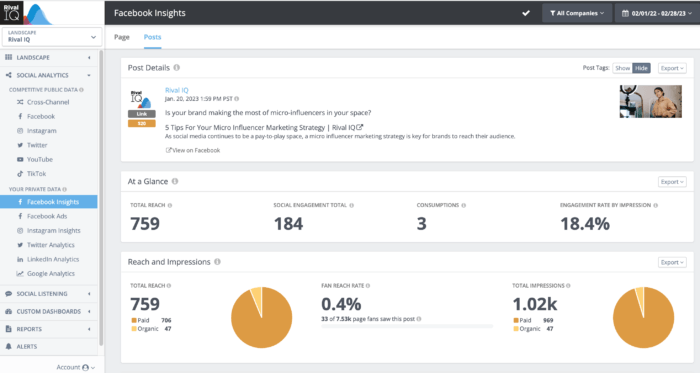
Instagram Reach vs. Instagram Impressions
Here’s how Instagram defines each metric:
- Reach is the number of unique users that have seen your content, at least once.
- Impressions are the number of times your content was on screen.
Through the native Instagram app, you can check your reach and impressions for individual posts, as well as your entire account during a specified period of time (shown below).
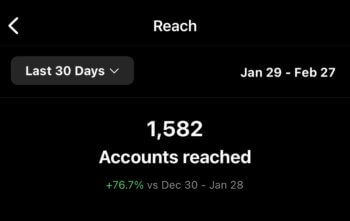
Notably, Instagram provides extra information about your reach that many platforms don’t. For instance, insights for an individual post include the number of people reached, as well as how many are followers versus non-followers.
Your Account Insights provides even more information about your account’s reach as a whole, which considers your reach across all content (Posts, Stories, Reels, Videos, Live Videos, and ads or promoted content). In addition to reporting the number of unique accounts that have seen your content, Instagram gives you insight into:
- Your ads and promotion data
- The top countries where your reached audience is concentrated
- The top cities where your reached audience is concentrated
- The gender distribution of your reached audience
- The age ranges for the largest segments of your reached audience
- The number of followers you’ve reached
- The number of non-followers you’ve reached
The advantage here is being able to know more about who you’re actually reaching and not just your follower base. This kind of information can help you switch up your targeting strategy or optimize your content in order to better achieve your goals.
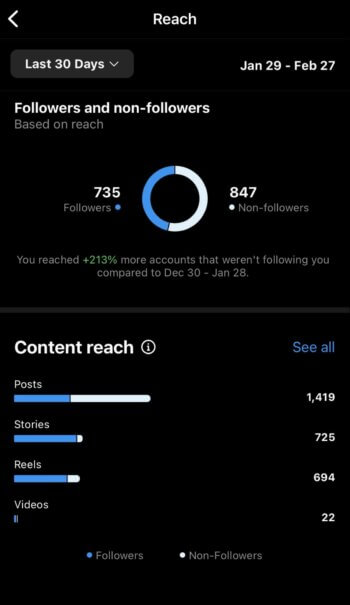
Twitter Reach vs. Twitter Impressions
Unlike most other social media platforms, Twitter does not track reach. Instead, the native Twitter app solely measures impressions, which it defines as the number of times people are served your Tweet in their timeline, search results, or from your profile.
Twitter reports metrics for your account as a whole, as well as for every single Tweet, which can be accessed through the various dashboards that the platform offers.

Since Twitter doesn’t report on how many unique accounts are served your Tweet(s), you’ll have to rely on impressions to get an idea of how great your reach is. Comparing your impressions to other available metrics like your follower count, past impressions, or even your competition’s impressions can help you paint a clearer picture of how well you’re doing.
TikTok Reach vs. TikTok Impressions
Now, for TikTok, reach and impressions look a little different.
Because it’s a video-based platform, “Total viewers” — not reach — is the verbiage that TikTok uses. This metric is available on each individual video’s analytics.
Similarly to Instagram, you have access to additional insights about your viewers. This includes:
- Gender, or the percentage of viewers that identify as female vs. male.
- Age, or the percentage of viewers that fall under certain age groups. This is only reported for viewers aged 18 and up.
- Top locations, or the percentage of viewers that are located in a particular country/region and city.
As for impressions, TikTok reports this metric as “views.” In other words, it’s not about how many times a post shows up on the screen but how many times the TikTok is viewed.
Video views for your entire account are available through the profile Analytics page, though TikTok only reports the views gained in the last seven days. Luckily, though, the platform reports lifetime views for every video you post, which includes not just the total view count, but also other helpful metrics including:
-
- Total Play Time, or the cumulative amount of time people spent watching the video.
- Average Watch Time, or the average amount of time people spent watching the video.
- Watched full video, or the percentage of views where the full video was watched.
- Retention rate, which shows a line chart that showcases the percentage of viewers that continued to watch at a particular timestamp.
- Traffic source, or where the views came from (For You page, your Profile, etc.)
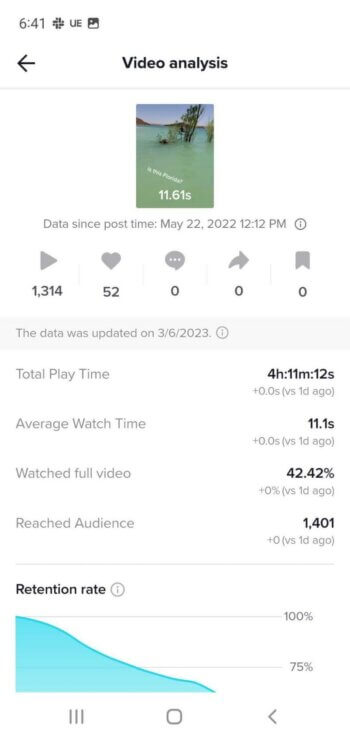
These extra statistics can give you immense insight into the quality of your videos. Not only can you see how many views your TikTok has amassed, but you’re able to understand whether your content is interesting enough to watch all the way through and when interest starts to dip.
LinkedIn Reach vs. LinkedIn Impressions
While LinkedIn technically tracks both metrics, the platform actually refers to reach as “unique impressions” in its analytics report.
LinkedIn defines each as follows:
- Unique impressions show the number of times your posts were shown to unique signed-in members. (This is equivalent to what most refer to as reach.)
- Impressions show the number of times each post is visible for at least 300 milliseconds with at least 50% in view on a signed-in member’s device screen or browser window.
What’s great about LinkedIn’s definition is how specific it is. Some interesting things to consider? 300 milliseconds is an incredibly short amount of time, meaning a user scrolling past a post without even glancing at it would still be considered an impression.
Also, only impressions by signed-in users are counted. Any views by anonymous or non-signed-in visitors who may have stumbled upon your post aren’t counted. In other words, just like on any other platform, take these numbers as an estimate of how many you’re reaching rather than a precise count.
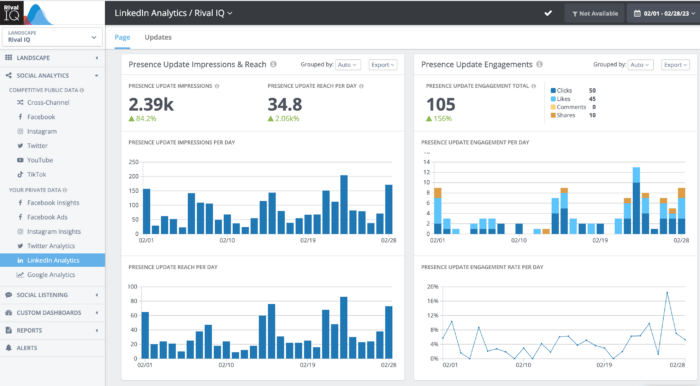
Still, it’s better to keep an eye on reach and impressions than not at all. LinkedIn reports these metrics for each post. It also tracks your Page’s total unique impressions and impressions over a particular period of time, which you can see in the image below. This can help you identify trends or outliers that can inform your social media marketing strategy moving forward.

Dig deeper into your brand's reach and impression metrics
Watch the videoThe Wrap Up
At the end of the day, neither reach nor impressions are inherently better than the other. Despite key differences, these two KPIs help you measure your exposure and provide much-needed context and insight into the quality and performance of your social media efforts.
Whether reach or impressions is most important for your brand will entirely depend on what your current goals and objectives are. Hopefully, though, this thorough breakdown has helped you understand the major differences between each, enabling you to make well-informed decisions moving forward.
